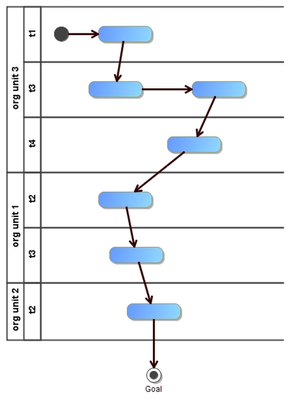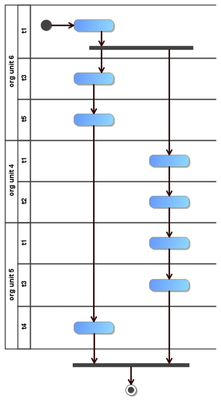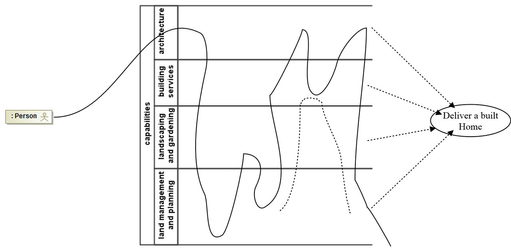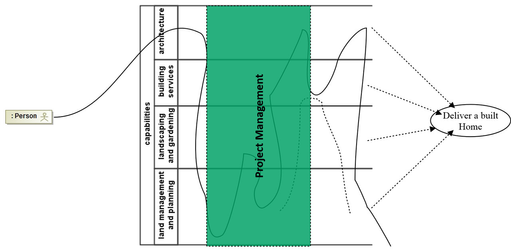Introduction
...
Alternatively one could choose to define capability using the architectural unification approach POLDAT
- Process (business processes)
- Organisation (structures)
- Location (Geographical information)
- Data (models, life cycles, security etc)
- Application (software, security, interoperability etc)
- Technology (infrastructure)
...
Our next task is to try and illustrate this weaving nature that we have described above? One approach that we are currently trying is to map the thread through a UML activity model. We use swimlanes to provide a visual way of representing organisational units and other sub units (do not confuse this model with value stream mapping, that is not what we are doing).
This model captures the weaving nature through our first example of one capability to deliver a goal |
|---|
Each blue round tangle represents an activity or set of activities being executed
In this example we show multiple capability paths delivering a goal |
|---|
So how does this help me
That's a very good question and it depends on your perspective; there are several advantages that I would like to describe and I am sure that you can think of others.
Partnership to deliver a goal(s)
in In this context the partners will have some clearly defined goals but, they will have similar or even the same set of capabilities which makes it easier to do like for like comparisons, allowing you to ignore the physical implementation e.g. comparing the check-in or baggage handling capabilities across airports. These partners will clearly want to know which of them has the best capability to help deliver the goal(s).
...
Once you have gone through the exercise of defining your capabilities (which when combined in certain ways deliver certain goals), it now becomes possible to combine those capabilities in other ways to discover what other goals can be achieved, in other words what opportunities do the new combinations create.
...
Once your capabilities are defined, begin to ask the following questions shown in the diagram below (for each answer you will need to map it to what you currently do in your organisation)
...
- architecture (building architect)
- building services (described above)
- garden landscaping
- land management (with planning permission) - a key resource !
It's now clear from the discussion above that there will be a certain amount of activities woven activities through each of these distinct capabilities to deliver the goal of a built "Deliver built built house"
By simply concentrating on the capabilities, you can begin to ask the following questions
- maybe there is a company that is capable of doing all of these things for me
- if I clearly define and price each capability I will be able to go to market and buy these in as building blocks
But it also raises a few questions
- if you go with option 1 above, you can leave it to the company to ensure that they have a project management capability to pull together the other capabilities together to deliver the home
- if I go for option 2, I will need to understand each of the capabilities in order to ensure that they work in a coordinated manner. In other words and . I.e. using POLDAT (what is the organisational structure I need to have in place to ensure that these capabilities function as one)
So we then start to see Whichever approach you take, the emergence of a complex matrix of capabilities to deliver our goal will begin to appear
So the reality then becomes as shown in the figure below. Here we see that the individual who wants the house built must interact with each organisation, clearly outlining their goals. A set of capabilities (comprised from the functionality within those organisations) will be assembled to deliver those goals. Note we have only shown one capability per organisation but there may be many.
...



